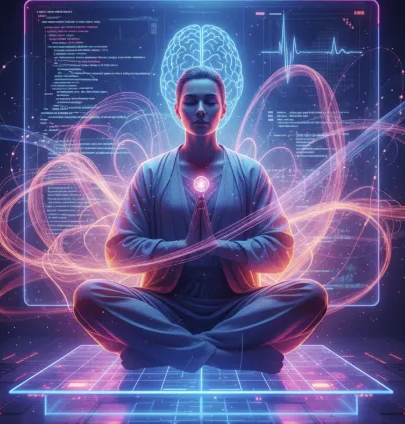“Vibe Coding” Requires More Discipline Than You Think

I learned to code the hard way. Now, I’m leaning into a new AI-powered workflow that feels like magic, but is grounded in timeless engineering principles.
I learned to code out of necessity, fueled by ideas and a stubborn refusal to wait for someone else to build them. My education wasn’t in a classroom; it was in the trenches. It was spending two hours on a 20-minute YouTube tutorial, wrestling with deprecated libraries at 2 AM, and celebrating the small victory of a single, bug-free function. I learned the craft through a slow, deliberate process of trial, error, and sheer grit.
That hard-won knowledge is the foundation of my career. And that is precisely why I am so excited, and cautiously optimistic, about a new paradigm that is emerging: “vibe coding.”
The term itself sounds almost whimsical. It’s the idea of translating an architectural “vibe” — the feel, the intent, the high-level design of a feature — into functional code through a conversational partnership with an advanced AI. I noticed the shift myself earlier this year.
The dialogue with my LLM partner moved from simple Q&A to deep, contextual
explanations. It started to feel less like a tool and more like a collaborator.
This new workflow is intoxicating. The speed at which you can move from a vague idea to a working prototype is staggering. But I’ve also learned that “vibe coding” without discipline is just a faster way to create elegant-looking, fundamentally flawed spaghetti code.
The real evolution isn’t the magic of “vibe coding.” It’s the professional discipline of Responsible AI-Assisted Development.
The Peril of the Black Box
The initial danger of this new paradigm is the temptation to treat the AI as a magical black box. It’s easy to throw a vague idea into the void, receive a massive block of code in return, and stitch it into your application without truly understanding it.
This is not just lazy; it’s reckless. Code you don’t understand is a liability. It contains hidden bugs, potential security vulnerabilities, and subtle logical errors that will inevitably surface at the worst possible moment. True ownership is impossible.
To embrace this new world responsibly, I’ve adopted a three-part framework that grounds the futuristic workflow in timeless engineering principles.
1. The Human is the Architect
I never start a new project with a blank file and a prompt. I start by being a developer. I sketch out the core engine of the solution myself — not just pseudocode, but a functional, minimalist skeleton of the application.
This initial, human-written code serves as the project’s constitution. It sets the architectural patterns, defines the core logic, and creates a solid foundation that the AI can then build upon. It’s the “vibe” made tangible.
By providing this strong initial direction, I’m not just giving the AI a task; I’m giving it guardrails. My hard-won foundational knowledge guides the AI’s generative power, ensuring that its contributions align with a sound and scalable architecture from the very beginning.
2. The AI is the Pair Programmer
With the foundation laid, the AI transitions into its ideal role: the ultimate pair programmer. It is a tireless collaborator, fluent in every framework, with instant access to all documentation.
Our workflow becomes a dialogue. I use a series of prompts to guide, verify, and collaborate:
“You are my co-developer. Here is the engine I’ve built. What do you think?” (Setting the context for collaboration.)
“Based on this engine, create a detailed task list to build out the full feature set.” (Turning the architecture into an actionable plan.)
“Let’s start with task #1. Can you generate the code for the user authentication module?” (Delegating the boilerplate.)
The AI handles the boilerplate, extends the functionality, suggests implementations, and refactors code at a speed I could never achieve alone. But it is always working within the architectural framework that I, the human architect, have defined.
3. The Human is the Chief Quality Officer
This is the most critical and non-negotiable step. All generated code must pass through a filter of rigorous human intelligence.
The AI is an incredible implementer, but it lacks true context. It doesn’t understand my specific business goals, my users’ hidden needs, or the long-term vision for the product. It can write code that is syntactically perfect but strategically flawed.
Therefore, my most important role in this new paradigm is that of the chief reviewer, tester, and ethicist. I take full ownership of the final product. I read, refactor, and test every significant block of generated code. I am the final backstop for the security flaws, the logical errors, and the subtle “misses” that an AI, for all its power, will always make.
The Future of Our Craft
There will be an outcry from purists who see this new workflow as a dilution of the craft of coding. I see it differently.
Code has never been about the act of typing; it has always been about the act of creation. It’s about turning an idea into a reality. Responsible AI-Assisted Development is a monumental leap forward in our ability to do just that.
This new paradigm doesn’t make deep technical knowledge obsolete; it makes it more valuable than ever. It elevates the role of the developer from a “line-level coder” to a true “architect and quality officer,” where the most critical skills are vision, critical thinking, and a deep understanding of the fundamentals.
I didn’t spend all those late nights learning the hard way just to protect old methods. I did it to build a foundation strong enough to launch from when the future arrived.
The future is here. Let’s get to building.